‘Variations’ at TimeLine: Seeking the solution to Beethoven’s obsession with a trivial waltz
Review: Chicago premiere of “33 Variations” by Moisés Kaufman, presented by TimeLine Theatre at Stage 773 through Oct. 21. ★★★
By Nancy Malitz
In “33 Variations,” the playwright Moisés Kaufman sheds light on Beethoven’s late life focus on a trivial little waltz, to which he wrote a towering set of 33 variations for piano solo, the greatest work of its kind. Kaufman’s agent in this riddle of Beethoven’s obsession is a modern Beethoven expert, herself in white hot pursuit of the composer’s reason why.
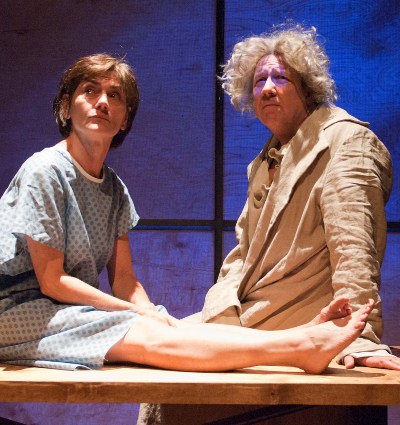 The historical Beethoven began writing his so-called Diabelli Variations in 1819, when he was 49, at the height of his compositional powers, yet otherwise in alarming physical decline — completely deaf, suffering from eye-strain and stricken with respiratory and digestive disorders that had prevented him from composing for long periods and drained him of cash.
The historical Beethoven began writing his so-called Diabelli Variations in 1819, when he was 49, at the height of his compositional powers, yet otherwise in alarming physical decline — completely deaf, suffering from eye-strain and stricken with respiratory and digestive disorders that had prevented him from composing for long periods and drained him of cash.
Our playwright’s contemporary counterpart is Dr. Katherine Brandt, a brilliant American scholar at the height of her intellectual command yet also betrayed by a middle-aged body’s sudden shutdown. She begins her odyssey to the German city Bonn, Beethoven’s birthplace, in spite of a terminal diagnosis of ALS, also called Lou Gehrig’s disease. She goes because she feels a compelling need to understand why Beethoven would choose to toil so long over a mediocre ditty, considering the little time he likely had left.
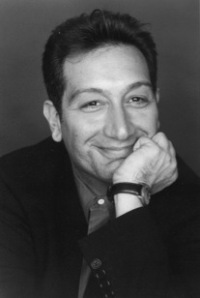 There’s another parallel between Beethoven and Brandt, although Kaufman doesn’t focus on it. Beethoven was engaged in a prolonged struggle for guardianship of his dead brother’s teenage son, Karl, from a mother he referred to as the Queen of the Night, after Mozart’s horrific opera villain. The great composer was determined to help Karl make something of himself. Brandt, likewise, is in despair over an adult daughter whose approach to life has been to try this, try that. Was this part of Kaufman’s original inspiration, to draw the parallel more closely?
There’s another parallel between Beethoven and Brandt, although Kaufman doesn’t focus on it. Beethoven was engaged in a prolonged struggle for guardianship of his dead brother’s teenage son, Karl, from a mother he referred to as the Queen of the Night, after Mozart’s horrific opera villain. The great composer was determined to help Karl make something of himself. Brandt, likewise, is in despair over an adult daughter whose approach to life has been to try this, try that. Was this part of Kaufman’s original inspiration, to draw the parallel more closely?
One would love to see the playwright’s sketches. Perhaps they’d hold the key.
But that would put me in Brandt’s shoes. As the play begins, the scholar is on her way to Bonn to peer into Beethoven’s sketchbooks, in which the composer’s ideas unfolded in an energetic jumble of inspirations alongside ideas that never went anywhere — all mixed with soup stains, ink blots and everyday scribbles.
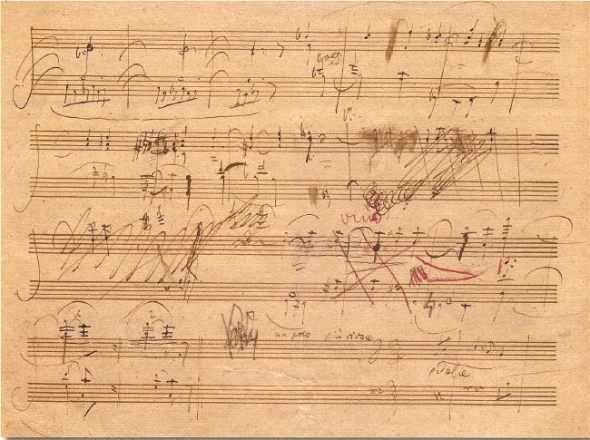 On Broadway, Brandt’s role was taken by Jane Fonda as a fragile, tetchy seeker in the actress’s well-received return to New York’s stage after 46 years away.
On Broadway, Brandt’s role was taken by Jane Fonda as a fragile, tetchy seeker in the actress’s well-received return to New York’s stage after 46 years away.
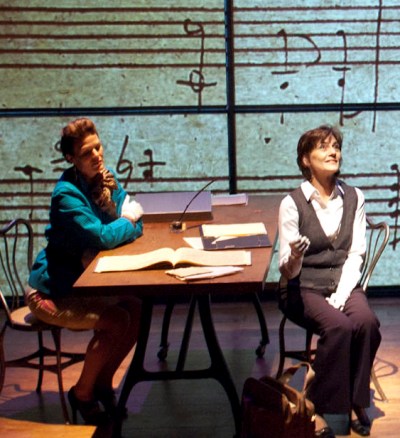 For the play’s admirable Chicago premiere, now in progress at TimeLine Theatre, Janet Ulrich Brooks plays Brandt as a younger sleuth who arms herself against self-pity with denial and sardonic wit.
For the play’s admirable Chicago premiere, now in progress at TimeLine Theatre, Janet Ulrich Brooks plays Brandt as a younger sleuth who arms herself against self-pity with denial and sardonic wit.
Brooks’ performance is a knockout, with the sparest hint of Don Quixote in it. And her partner in this quest is the equally impressive Juliet Hart, as the über-spiky Bonn librarian Dr. Gertrude Ladenburger, whose acerbic practical assistance soon becomes guidance in matters other than musicological. (This librarian is hardly a Sancho Panza, although she does get in a few unforgettable sanchismos in one hilariously raunchy scene of comic relief.)
Beethoven’s sketches were intended only for the composer’s eyes, often jotted in a kind of musical shorthand, as if to remind himself of fleeting ideas. They are therefore extremely difficult to decipher, but as such they are also potential keys to understanding those instances of creative spark, the mustard seeds, the God particles of Beethoven’s process. Or so the sketchbooks would seem, to the right eyes.
 Indeed, the passages in Kaufman’s play that illuminate Brandt’s discoveries — gently assisted by Ladenburger as the keeper of the sketchbooks’ flame — are the drama’s most exquisite moments.
Indeed, the passages in Kaufman’s play that illuminate Brandt’s discoveries — gently assisted by Ladenburger as the keeper of the sketchbooks’ flame — are the drama’s most exquisite moments.
Enter projections designer Mike Tutaj (at right), scenic designer Brian Sidney Bembridge, sound designer Andrew Hansen and a live pianist onstage underscoring the action with Beethoven’s own music. (I witnessed the gifted Igor Lipinski; others may hear George Lepauw.)
It is an ace technical team directed by Nick Bowling that helps the audience share in these epiphanies. An elaborate choreography of visual projections seems to follow Beethoven’s jottings as he writes them. The visuals are in fine sync with dialogue intended to guess at Beethoven’s thoughts as the snippets are performed live. You don’t need to be able to read the music to get the idea of the restless mind at work in these moments.
 In its best scenes, Kaufman’s “33 Variations” reminds one of Peter Shaffer’s “Amadeus,” which sheds such fine light – as the character Salieri puts it — on the imperfect human packages into which God installs genius. There’s an unforgettable scene in “Amadeus” in which the ambitious Mozart sits down at the keyboard in front of Emperor Joseph II and assorted elite composers who all outrank him, off-handedly transforming a bad march by Salieri into a tune that would shortly make Mozart famous.
In its best scenes, Kaufman’s “33 Variations” reminds one of Peter Shaffer’s “Amadeus,” which sheds such fine light – as the character Salieri puts it — on the imperfect human packages into which God installs genius. There’s an unforgettable scene in “Amadeus” in which the ambitious Mozart sits down at the keyboard in front of Emperor Joseph II and assorted elite composers who all outrank him, off-handedly transforming a bad march by Salieri into a tune that would shortly make Mozart famous.
But “33 Variations” also has some unevenness that proved hard for TimeLine’s actors to overcome, even with Bowling’s fast-moving sequence of 33 scenes and the creative team’s stunning imagery. There is an unforgettable series of Brandt’s near-death body scans, her bones and sinews eerily cross-hatched with the spiny staves of Beethoven’s Missa Solemnis, while heart-breaking music soars.
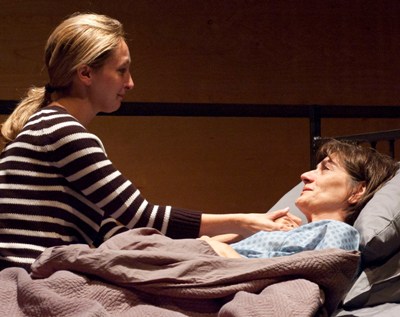 There is so much to recommend in this production that it is sorely felt when some of Kaufman’s supporting characters seem barely sketched, even tending toward caricature.
There is so much to recommend in this production that it is sorely felt when some of Kaufman’s supporting characters seem barely sketched, even tending toward caricature.
As Dr. Brandt begins her final, precipitate plunge, she is joined in Bonn by the daughter whom she so misunderstands (Jessie Fisher as Clara). Clara does have a key role in a late scene, when she is heard absent-mindedly humming the Diabelli tune, to her mother’s and Dr. Ladenburger’s astonishment and subsequent jubilant insight. Elsewhere it is hard to escape the notion that Clara’s primary purpose in this play is to help Kaufman connect the narrative dots.
Clara’s boyfriend (played by Ian Paul Custer) is a nurse with experience in ALS cases, and he has tagged along to Bonn. Dr. Ladenburger, as it happens, also has first-hand knowledge of ALS. It’s one of those coincidences requiring a suspension of disbelief. Had Kaufman seen the graphic job that TimeLine’s visual-audio team does in depicting Brandt’s decline, he might have decided to lighten up on the medical edification.
If Terry Hamilton as Beethoven came off as more cantankerous madman than genius, there’s not much in the play’s lines to argue otherwise. Matthew Krause, who plays Beethoven’s amanuensis Anton Schindler as a somewhat self-serving and frustrated helpmate, rises above the odd comic book line.
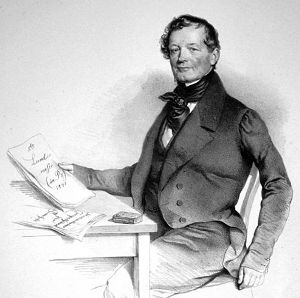 Michael Kingston gives a meaty interpretation of the composer Diabelli, who was also was a publisher of many of Beethoven works. Diabelli was historically successful as a composer of light tunes in his day, including the now-famous waltz for which he invited a single variation from each of 50 Viennese composers, never expecting that Beethoven’s response would be an avalanche of 33. Diabelli may have been a shrewd businessman but, like Schindler, he was also a musician with a professional understanding of just how much greater Beethoven was.
Michael Kingston gives a meaty interpretation of the composer Diabelli, who was also was a publisher of many of Beethoven works. Diabelli was historically successful as a composer of light tunes in his day, including the now-famous waltz for which he invited a single variation from each of 50 Viennese composers, never expecting that Beethoven’s response would be an avalanche of 33. Diabelli may have been a shrewd businessman but, like Schindler, he was also a musician with a professional understanding of just how much greater Beethoven was.
So why did Beethoven spend all that time on Diabelli’s tune? Even Beethoven might not have been able to answer that one. Like many artists, he thought of inspiration as something that just comes. In 1823, shortly after his Diabelli Variations were finally published, the composer urged his prize pupil and most valued patron, the Archduke Rudolf, to chase his own spark thusly:
“Your Royal Highness has only to persevere, especially to accustom yourself to write down your ideas at once at the piano, quickly and briefly. By this means you learn instantly to hold fast to the most fugitive ideas. The ability to represent precisely what we wish and feel then comes about but by degrees.”
Related Links:
- Listen to each of Beethoven’s 33 Diabelli Variations: Go to www.beethoven-haus bonn.de
- Download the “33 Variations” Study Guide: Go to timelinetheatre.com
- Moises Kaufman talks about his play: See it at youtube.com
- “Life of Beethoven by Anton Schindler”: Read it at gutenberg.org
- TimeLine’s 2012-13 season preview: Details at www.ChicagoOntheAisle.com
Captions and credits: Home page and top: Juliet Hart, Janet Ulrich Brooks and George Lepauw in a wide stage shot of the Chicago premiere of “33 Variations” by Moisés Kaufman. Descending: Janet Ulrich Brooks as Dr. Katherine Brandt meets across time with Terry Hamilton as Beethoven to consider what’s important at life’s end. Playwright Moisés Kaufman. Beethoven’s working manuscript for the ending of Diabelli Variation 14 and beginning of Variation 15. (Courtesy Beethoven-Haus Bonn) Juliet Hart as Dr. Gertrude Lautenberger and Janet Ulrich Brooks as Dr. Katherine Brandt contemplate what Beethoven was thinking as he sketched. Projections designer Mike Tutaj. Janet Ulrich Brooks as Dr. Katherine Brandt is ravaged by ALS. Daughter and mother — Jessie Fisher as Clara and Janet Ulrich Brooks as Dr. Brandt – struggle for reconciliation as death approaches. Composer and music publisher Anton Diabelli, lithograph by Josef Kriehuber. Below: George Lepauw at the piano with Terry Hamilton as Ludwig van Beethoven thinking aloud. Pianist George Lepauw with Janet Ulrich Brooks as Dr. Katherine Brandt arriving in Bonn, Germany, Beethoven’s birthplace. Diabelli’s waltz theme. (“33 Variations” production photos by Lara Goetsch.)
Tags: 33 Variations, Beethoven, Beethoven-Haus, Diabelli, George Lepauw, Ian Paul Custer, Igor Lipinski, Janet Ulrich Brooks, Jessie Fisher, Juliet Hart, Matthew Krause, Michael Kingston, Moisés Kaufman, Schindler, Terry Hamilton, TimeLine Theatre

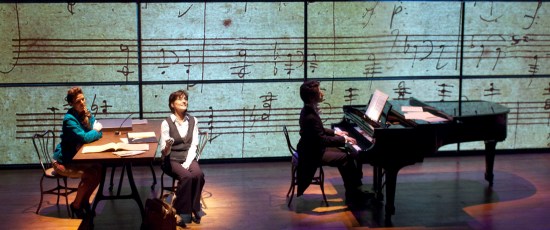
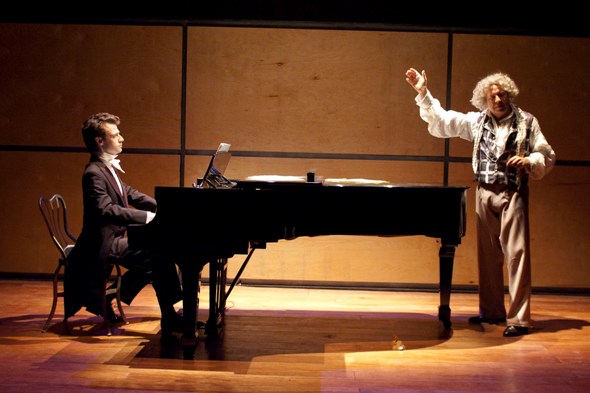
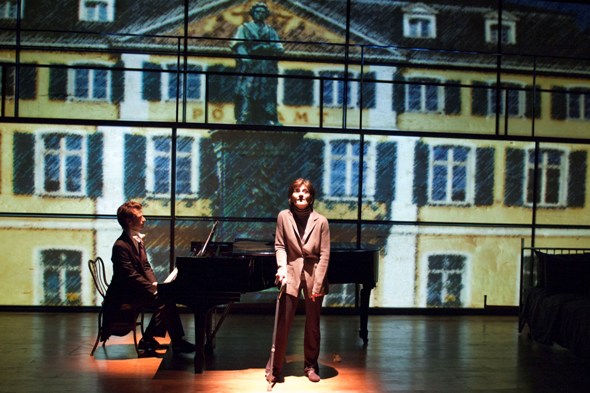
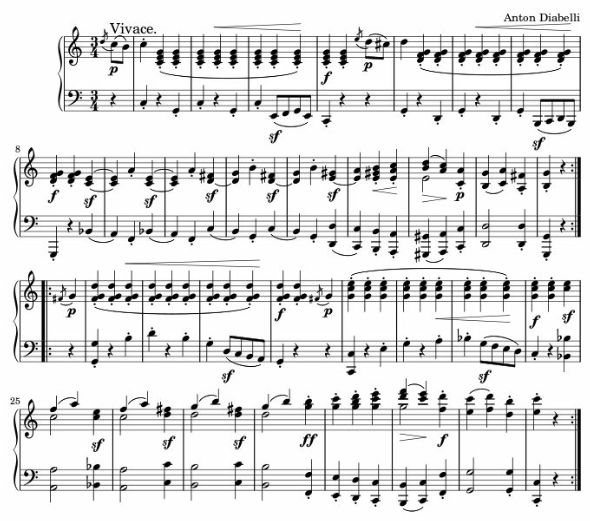

No Comment »
1 Pingbacks »
[…] not just for math buffs or precocious scholars. It echoes the impact of Timeline’s 2012 hit “33 Variations” by Moisés Kaufman, which brought to life Beethoven’s obsession with a trivial little waltz […]